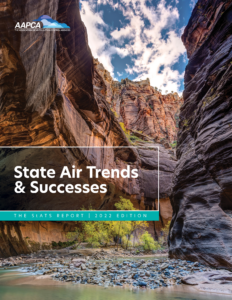FOR IMMEDIATE RELEASE
AAPCA Releases 2022 Edition of State Air Trends & Success: The StATS Report
States and local governments continue to be central to nation’s air quality success
April 19, 2022
Lexington, KY
The Association of Air Pollution Control Agencies (AAPCA) has released the 2022 edition of State Air Trends & Successes: The StATS Report, which focuses on the core role of state and local agencies in improving air quality in the United States. The annual publication of State Air Trends & Successes: The StATS Report comes ahead of Earth Day (April 22) and Air Quality Awareness Week (May 2 to 6).
The StATS Report, first published in April 2017, uses publicly available data from the U.S. Environmental Protection Agency (EPA) and other agencies to catalogue trends and metrics for key programs under the Clean Air Act, including the cornerstone national ambient air quality standards, or NAAQS, program. Progress is also detailed for toxic air releases, compliance and enforcement activities, greenhouse gas emissions, and visibility for national parks.
“State and local agencies are proud of the work they do to meet their mission of protecting air quality,” AAPCA President Bryce Bird, Director of the Utah Division of Air Quality, stated about today’s release, “and The StATS Report shows that they continue to be critical partners with EPA on important and emerging environmental priorities.”
AAPCA Vice President Mike Abraczinskas, Director of the North Carolina Division of Air Quality further noted, “Air quality is tracked by the nation’s monitoring network. State and local agencies administer this vital infrastructure in coordination with EPA to ensure air quality meets national standards and community concerns are appropriately addressed.”
Highlights from the 2022 edition of AAPCA’s State Air Trends & Successes: The StATS Report include:
- In the 50 years from 1970 to 2020, the aggregate emissions of the six criteria air pollutants under the NAAQS program in the United States has been reduced 78 percent.
- Since 2000, AAPCA Member States oversaw a combined 52 percent reduction in criteria pollutant emissions.
- From 2010 to 2020, reported toxic air releases were reduced 36 percent (314.2 million pounds), with AAPCA Member States responsible for 66 percent of the total reduction.
- From 1990 through 2020, electricity sector emissions of sulfur dioxide and nitrogen oxides declined 14.9 million tons (95 percent) and 5.6 million tons (89 percent), respectively. In that 30-year period in the sector, AAPCA Member States accounted for about 65 percent of sulfur dioxide emissions reductions and 61 percent of nitrogen oxides emissions reductions.
- Total energy production in the U.S. increased 42 percent from 1999 to 2019, a period in which the nation reduced energy-related carbon dioxide emissions nearly 10 percent.
The full 2022 edition of AAPCA’s State Air Trends & Successes: The StATS Report is available at: https://cleanairact.org/wp-content/uploads/2022/04/AAPCA-2022-StATS-Report.pdf
Air Quality Awareness Week (#AQAW2022) is hosted by the U.S. EPA and other federal partners, and more information can be found here.
AAPCA Background
The Association of Air Pollution Control Agencies, or AAPCA, is a national, non-profit, consensus-driven organization focused on assisting state and local air quality agencies and personnel with implementation and technical issues associated with the federal Clean Air Act. Created in 2012, AAPCA represents 48 state and local air pollution control agencies, and senior officials from 21 state environmental agencies currently sit on the AAPCA Board of Directors. AAPCA is housed in Lexington, Kentucky as an affiliate of The Council of State Governments. More information about AAPCA can be found on the Association’s website: www.cleanairact.org.
Association of Air Pollution Control Agencies | 1776 Avenue of the States | Lexington, Kentucky 40511
www.cleanairact.org | @AAPCA_States
Contact: Jason Sloan, Executive Director (jsloan@csg.org / 859-244-8043)
